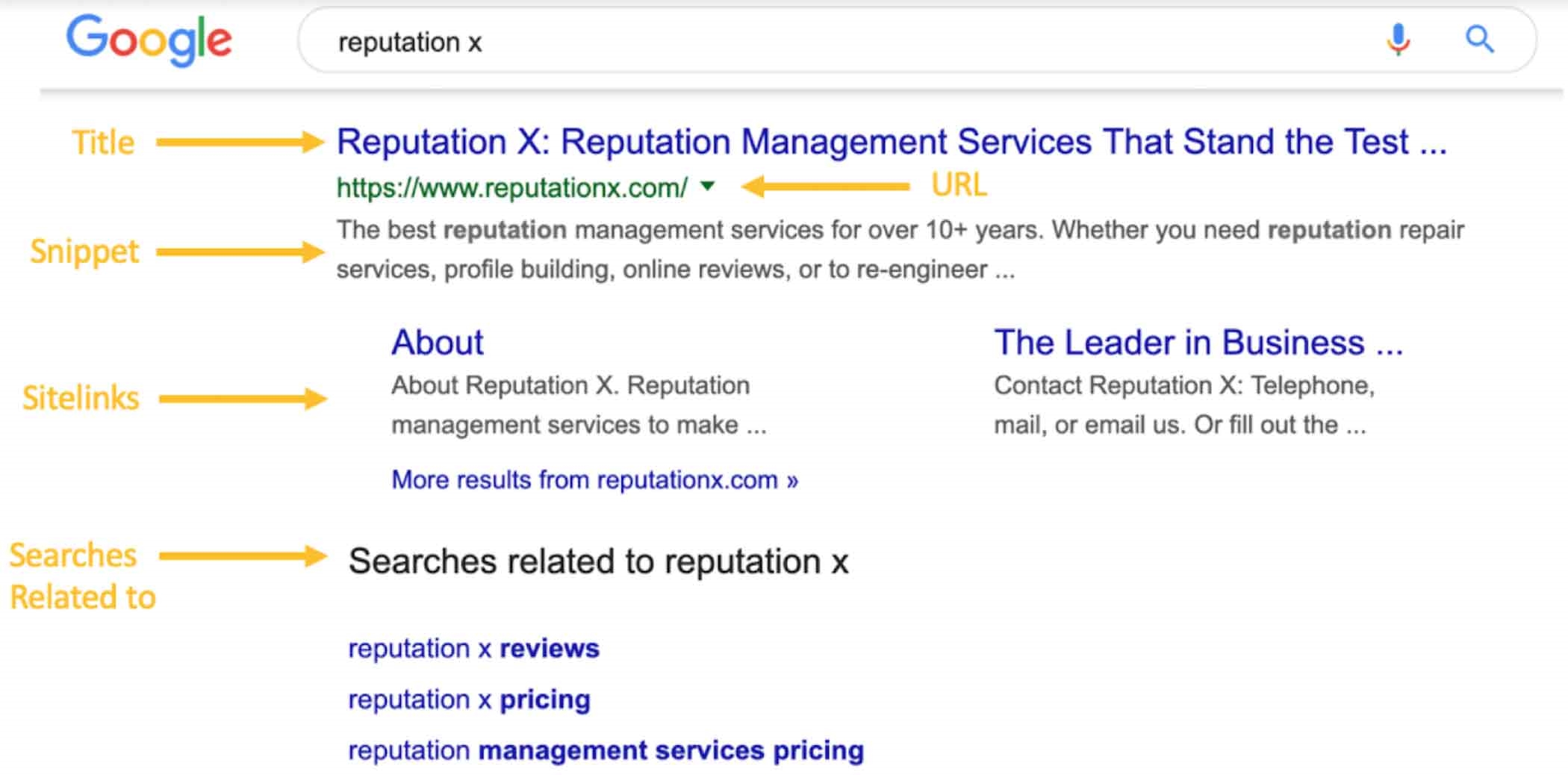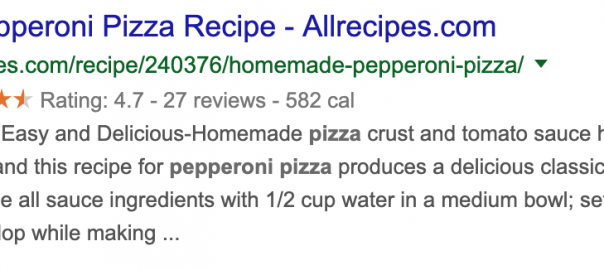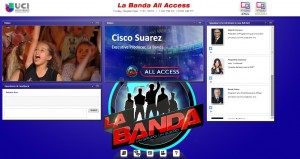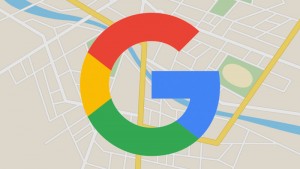— April 19, 2019
It takes hard work to snag a spot on the first page of Google search results. There are many aspects to consider, such as creating relevant content, incorporating relevant keywords and links, and crafting an enticing search result that makes people want to click on it. But before you can craft content that excels, you need to understand how it might be displayed.
- Understanding the anatomy of a search result page can help you craft your content in a way that entices people to click your link.
- Structure, organize, and promote your content effectively to rank high in SERPs.
- Update and refresh content to keep your content relevant.
Getting your page to rank well in search results is tough, but the payout is often worth the effort. In fact, a study recently found that the first page of Google receives 95 percent of web traffic. There are some basic components that every page should have, and this blog post will provide tips to create a high-ranking page as well as a guide to the anatomy of a search results page.
Components of a search engine results page
Before you can create an effective search engine results page you need to understand the components of one. Google provides a good primer on how to create good titles and snippets in search results but there’s far more to consider. Here are the main parts of a Google search result, later we’ll look at more sophisticated information structures.

Title
Your title is the first, and often only, part of your search result that people read. Keep it short and relevant while still providing enough information to give the reader a good idea of what your page is about. The maximum length for a title tag is about 70 characters. This is a good tutorial on how to write a solid Title tag.
URL
You’ll want to apply the same principles for your URL as you did for your title tag. Make sure your URLs are relevant and short, but still provide enough information to adequately display what they page is about. You will often find time stamps underneath the URL. This is common for blogs and news articles to highlight the freshness of the content. Make sure to refresh your content regularly to avoid people mistaking your work as old or irrelevant.
Snippet
The snippet is the description of the page and is usually limited to about 156 characters. While the snippet may be the meta description that you wrote, Google sometimes sources the snippet from contextual information on the page. This allows Google to tailor the snippet to each unique search query to provide relevant information pertaining to that search. They don’t “make up” words though, they pull it from your content – just not always from the same place. So it’s not only important to write an effective meta description, but also to incorporate easy-to-digest chunks of information throughout the page that Google can identify and source.
Then there are rich snippets. Rich snippets provide additional information, such as a photo or a star rating. Since rich snippets are more visually pleasing and offer a better jumping-off point, they often have higher click through rates. You can increase your chances of getting a rich snippet by adding structured data to your site. A rich snippet looks like this:

Getting snippets to rank at the top of search results
This position is called Position Zero or Featured Snippets. It’s where Google places what it believes to be the best “instant answer” to the query. If your content is already on page one, and you’ve structured your content correctly, it may be featured above all other search results.
Sitelinks
Sitelinks are additional sub-listings that appear underneath the first Google search result, usually for recognizable brands and organizations. These links provide a quick way for people to jump to the correct page on a website. The maximum allotted number of sitelinks is six. Well-structured websites with unique content and a clear site hierarchy are more likely to have sitelinks. Want to know more about sitelinks – this is a good resource.
Searches related to
The searches related to section shows other top search queries that relate to the one that you originally searched. This section is a great place to source other keywords to include in your content. Sprinkle these keywords throughout your content and consider incorporating a few into your subheads.
More complex search results
The screenshot above reveals the most common search result structure, but others can be more complex. What you see on a SERP depends on the type of information you are searching for. Take Wells Fargo for example:
This search result includes more complexity:
Knowledge graph
The Knowledge Graph is a knowledge base used by many Google properties that was launched in 2012. Users see it as an info box or knowledge cards.
Where does Knowledge Graph get its information? It pulls information from many trusted sources including Wikipedia, the CIA World Fact Book, schema information and more.
The Knowledge Graph works behind the scenes to collect and analyze large amount of data in order to present its findings in an effective way to answer specific search queries. The data and information gathered by the Knowledge Graph powers the visible components of SERPs, including the Knowledge Graph Card, featured snippets, and carousels.
Knowledge graph card
The Knowledge Graph Card displays information compiled by the Knowledge Graph and is found on the right side of the SERP. The Wells Fargo Knowledge Graph Card displays a snippet from Wikipedia, as well as the CEO, a customer service number, and links to social media profiles. Google tends to pull information from established databases like Wikipedia; however, there are a few ways to increase your chances of appearing in a Knowledge Graph Card. Start with improving site attributes like:
- Business details like physical location and contact information
- Marketing details like your official name, logo, and social profile info
Google map
For local searches you’ll often see a Google map show up with nearby locations. Google Maps provides geographical information for locations around the world. It includes arial maps, road maps, street view maps taken from Google vehicles, and more. Google maps data is often added into search result data, especially for local queries.
How do you get your business on Google Maps? Sign up for Google My Business and add each of your locations as well as other relevant information about your business. Google will use that information to populate your map location in search results.
Top stories
When the entity being searched generates enough news coverage a top stories section will appear at the top of the SERP. The top stories are pulled directly from the News tab and are mainly sourced from credible news sites.
Google now includes results from Twitter in many search results. This section doesn’t appear as often as top stories, but it is a testament to the growing impact and legitimization of social media. This section shows up when a brand is highly active on Twitter and shows the most recent tweets in full.
Carousels
Google uses clickable image strips called carousels for many items. Examples include images of people, like the male supermodels pictured above or the cast of a movie, or images of things, like types of lilies. When you search for a list of items it is more likely that a carousel will appear.
How to get content to show up in search results
Your content is the foundation of your page. Without a strong foundation, any superficial attempts to improve your SEO will be made in vain. The overall structure of your content should aim to inform, teach, and improve your reader’s knowledge of your topic.
How you structure content is important
There is no single formula on how to create and structure your content to rank well because different entities are treated in various ways. A local business needs to structure content differently than a global organization. However, there are some best practices that can give your content a good chance of ranking well.
How to get written content to rank well
Start with research. Read the top five articles that already exist on the topic and aim to make yours better and longer. Long-form content of more than 1,800 words tends to rank better than shorter pages. The more detail the better – aim to provide enough detail and examples that a person reading your page won’t have any questions about your topic once they are finished reading.
Relevant links to expert related content
It is also important to include relevant links to further illustrate details. Think about how Wikipedia works and emulate. Of course the best content to link to is your own content that already lives on your site, but if you don’t have that content in place, or the site you publish on is not yours, then by all means branch out to other expert content.
Establish your content as the authority on the topic by creating a hub of helpful information. This means researching relevant statistics, current events, and any other information. Discuss these topics in your page and link to outside sources (If it isn’t on your site) to validate your statements and provide more detail.
How to organize your content
While long blocks of text have a time and a place, they aren’t the most effective way to get your content to rank well in the SERPs. Especially now that most people are digesting web content on the go from their mobile phones. Organize your content into sections that each touch on a specific part of your overall page. You want people to be able to quickly scroll through your page and find the exact information they are looking for. The following page components help make that happen.
- Subheads: Use subheads throughout your page to break your information into sections. Your keywords should be appearing in your main headline and your subheads as often as feels natural. Don’t force your keyword into every subhead, but it should appear at least once in your H1 (the main heading of your page).
- Bullet points: Bullet points are extremely effective at pinpointing important information for the reader. They also help Google understand the main points.
- Summary: By providing a summary at the top of your page you give readers a quick intro to what your page is about and provide a nice snippet that the SERPs can crawl. A good summary can also increase your chances of getting into Google’s position zero, which appears first in search results, usually below paid advertisements.
- Call to action: A call to action at the end of your page answers the question “What’s next?” Engage your readers with a call to action that provides a solution to their problem and encourages them to start communicating with you.
Promote your content
Once you have created a solid webpage complete with helpful content, relevant backlinks and shareable headlines, it’s time to share it with the world.
- Share your post to your social media accounts to reach a wider audience, and schedule your Twitter posts to repeat at a relevant rate. There’s no reason to post just once.
- If you have a budget, create sponsored social media posts that link back to your page.
- Contact relevant influencers to link to your post from their blog, website, or social media profiles.
Conclusion
Building a page that dominates in search results takes time. If you put in the work to create helpful, relevant and informative pages, you have a higher likelihood of landing on page one of Google search results. By understanding the parts of a Google search result you can design your page for success.
Digital & Social Articles on Business 2 Community
(113)
Report Post







